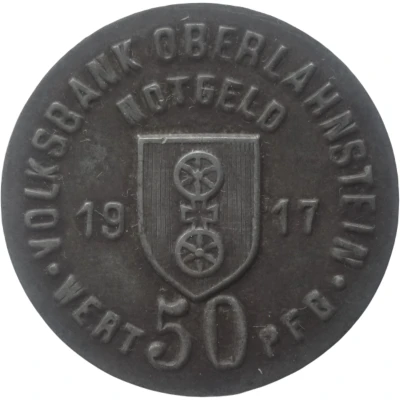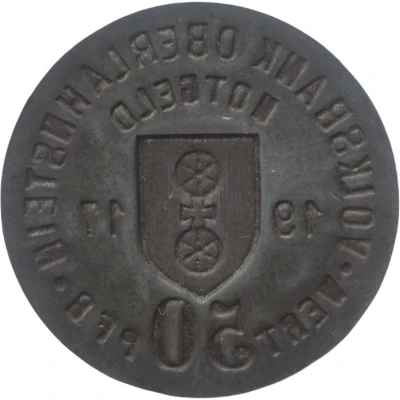


© Willem63 (CC BY-NC-SA)
50 Pfennigs - Oberlahnstein
1917 year| Iron | 2.3 g | 27.1 mm |
| Issuer | City of Oberlahnstein (Prussian province of Hesse-Nassau) |
|---|---|
| Issuing bank | Volksbank Oberlahnstein |
| Emperor | William II (Wilhelm II) (1888-1918) |
| Type | Standard circulation coin |
| Year | 1917 |
| Value | 50 Pfennigs (50 Pfennige) (0.50) |
| Currency | Mark (1914-1924) |
| Composition | Iron |
| Weight | 2.3 g |
| Diameter | 27.1 mm |
| Thickness | 0.9 mm |
| Shape | Round |
| Technique | Milled |
| Orientation | Medal alignment ↑↑ |
| Demonetized | Yes |
| Updated | 2024-10-04 |
| Numista | N#348724 |
|---|---|
| Rarity index | 93% |
Reverse
Lettering from obverse in mirror image
Edge
Plain
Interesting fact
One interesting fact about the 50 Pfennigs - Oberlahnstein 1917 coin is that it was issued during a time of economic turmoil in Germany, known as the "Inflationary Period" (1914-1923), when the value of the German mark plummeted, and the prices of goods and services skyrocketed. As a result, the government was forced to produce coins with lower denominations, such as the 50 Pfennigs, to keep up with the rapidly increasing prices. This coin, in particular, was made of iron, which was a cheaper alternative to other metals, and it weighed only 2.3 grams, making it one of the lightest coins in circulation at the time. Despite its low value, the coin remains a valuable collector's item today, serving as a reminder of a tumultuous period in German history.
Price
| Date | Mintage | VG | F | VF | XF | AU | UNC |
|---|---|---|---|---|---|---|---|
| 1917 | 5000 | - | - | - | - | - | - |
Values in the table are based on evaluations by sales realized on Internet platforms. They serve as an indication only for 50 Pfennigs - Oberlahnstein 1917 coin.